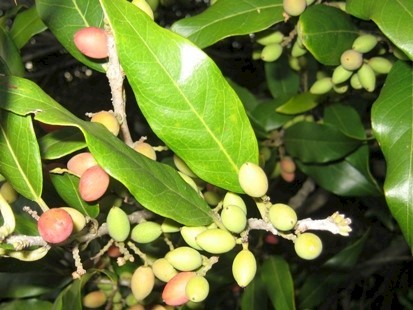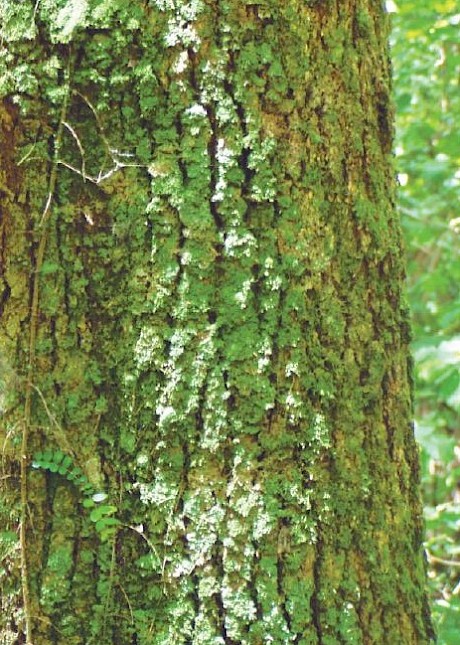Black Maire (Nestegis cunninghamii)
History
The Maori apparently had no medicinal use for black maire but its timber was highly regarded; mainly being used for weapon and tool construction. For example wedges for splitting wood, kō (digging sticks), canoe paddles and bailers, beaters, mallets and, while too heavy for some weapons, was used for thin, double pointed spears. Early European uses were much the same; eg, as caulking mallets, mauls, wheel or shaft bearings, but also as framing for railway carriages, fencing and bridge building materials. It was also used for cabinet making and turnery. However one of its main uses is as firewood for it is probably the best indigenous timber for this purpose.
Distribution
New Zealand’s four species of Nestegis are our only members of the Olive family and in earlier years was included in the same genus as the olive, Olea. The species is found in lowland forest from near North Cape to the Marlborough Sounds but is most common in the Central North Island.
Tree size and growth
 Ripe fruit are red or yellow.It is recorded in The Flora of New Zealand, Vol. 1 as growing to 20 metres tall and 1.5 metres in diameter; the only tree recorded by Burstall and Sale being a little smaller than this. Growth rates of planted black maire comes from few sources but gives an average annual height growth of 25 cm (max. 36 cm) and an average annual diameter growth of 6mm (max. 12 mm). A problem, as with many broadleaves, is that maire appear to be a favoured food sources for goats and deer; protection is essential.
Ripe fruit are red or yellow.It is recorded in The Flora of New Zealand, Vol. 1 as growing to 20 metres tall and 1.5 metres in diameter; the only tree recorded by Burstall and Sale being a little smaller than this. Growth rates of planted black maire comes from few sources but gives an average annual height growth of 25 cm (max. 36 cm) and an average annual diameter growth of 6mm (max. 12 mm). A problem, as with many broadleaves, is that maire appear to be a favoured food sources for goats and deer; protection is essential.
Timber
The most notable characteristic of black maire is its density; of New Zealand species only southern rata is heaver. The heartwood is reputedly quite durable, as evidenced from its use as a fencing material, but its durability has not been tested. In the 1880s it was obviously regarded as a very valuable timber. Fleet quotes average sawn timber prices in 1885 of 25 shillings ($397 in 2007) per 100 board feet for black maire, but only 12 shillings ($191) for totara and 6/6d ($103) for rimu. The black maire value converts to $1682 per m³ sawn in 2007.
In recent years the small quantity of black maire coming on to the market is used for turnery - it being regarded as one of the finest turning timbers: golf putters, the springyness which makes it suitable for mauls having a similar effect on golf balls, and the wooden parts of flutes and bagpipes. According to wood-turner Dick Veitch it is the only native timber on which a thread can be successfully turned.
Timber characteristics, with P. radiata figures shown in brackets for comparison, are:
Density (at 12% M.C.) 995kg/ m³ (500 kg/m³)
Moisture content green 43% (130%)
Tangential shrinkage 5.4% (4.7%)
- green to 12% m.c.
Radial shrinkage 2.6% (2.2%)
Modulus of rupture (air dry) 114 Mpa (90 Mpa)
Modulus of elasticity (air dry) 11.6 Gpa (9 Gpa)
Potential
 Black Maire has rough, corky bark. Photo: H Janssen, Bush Vitality AssessmentBlack maire is one of our least understood timbers but has potential for many high value uses, particularly in veneer and turnery but also cabinet making for which it seems to have been little used in recent years. Just why huge quantities were used as firewood when it had higher value for other uses is unknown. One can only hope that only low grade wood was burnt.
Black Maire has rough, corky bark. Photo: H Janssen, Bush Vitality AssessmentBlack maire is one of our least understood timbers but has potential for many high value uses, particularly in veneer and turnery but also cabinet making for which it seems to have been little used in recent years. Just why huge quantities were used as firewood when it had higher value for other uses is unknown. One can only hope that only low grade wood was burnt.
As it is closely related to the olive and has a similar prolific fruiting habit it may have potential for oil production, but as far as is known only one small study on the chemistry of the fruit has been done.
Research requirements
Initial small trials suggest that the growth rate of black maire may be faster than previously thought, since one plantation covered by F.R.I’s survey of the mid 1980s had diameter growth as fast as 1.2 cm M.A.I. Trials are urgently needed in areas where it can be protected from animals for the first few years. It is also likely that it will perform best on higher quality forest soils. Initial trials suggest that the growth habit is fairly upright. As its durability is uncertain and it is slow to dry and cannot be kiln dried, further trials of these aspects are also needed.
References
- Allan H H. 1961. Flora of New Zealand Vol. 1 Government Printer Wellington
- Clifton N C 1990. New Zealand timbers
- Pardy G F, Bergin D O & Kimberley M O 1992. Survey of Native tree plantations. FRI Bulletin 175
- Brooker S G, Cambie R C & Cooper R C 1988. Economic native plants of New Zealand. Botany Division D.S.I.R
- Burstal S W & Sale E V 1984. Great Trees of New Zealand. Reed
- Corkhill T 1948. A glossary of wood. Nema Press Ltd, London. 656p
- Fleet H 1984. New Zealand’s Forests. Heinemann
Species profile by Ian Barton


